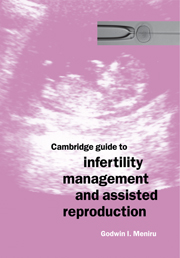Book contents
- Frontmatter
- Contents
- Preface
- Foreword
- Acknowledgements
- Introduction
- 1 The male reproductive system
- 2 The female reproductive system
- 3 Fertilization, implantation and early development
- 4 Male factor problems
- 5 Female factor problems
- 6 Evaluation of the infertile couple
- 7 Medical and surgical treatment of infertility
- 8 Conventional in-vitro fertilization treatment
- 9 Intracytoplasmic sperm injection
- 10 Surgical sperm retrieval
- 11 Intratubal replacement of gametes and embryos (GIFT, ZIFT)
- 12 Intrauterine insemination
- 13 Cryopreservation of gametes, ovarian tissue, testicular tissue and embryos; frozen embryo replacement
- 14 Assisted hatching
- 15 Preimplantation diagnosis of genetic disease
- Appendix: Acronyms in assisted reproduction technology
- Index
3 - Fertilization, implantation and early development
Published online by Cambridge University Press: 11 September 2009
- Frontmatter
- Contents
- Preface
- Foreword
- Acknowledgements
- Introduction
- 1 The male reproductive system
- 2 The female reproductive system
- 3 Fertilization, implantation and early development
- 4 Male factor problems
- 5 Female factor problems
- 6 Evaluation of the infertile couple
- 7 Medical and surgical treatment of infertility
- 8 Conventional in-vitro fertilization treatment
- 9 Intracytoplasmic sperm injection
- 10 Surgical sperm retrieval
- 11 Intratubal replacement of gametes and embryos (GIFT, ZIFT)
- 12 Intrauterine insemination
- 13 Cryopreservation of gametes, ovarian tissue, testicular tissue and embryos; frozen embryo replacement
- 14 Assisted hatching
- 15 Preimplantation diagnosis of genetic disease
- Appendix: Acronyms in assisted reproduction technology
- Index
Summary
Introduction
Fertilization of the oocyte is one of the key events of conception. However, for this to happen, the spermatozoa has to undergo a difficult journey up the female genital tract from the hazardous vaginal environment, through the screening mechanisms of the cervix and traverse the relatively long distance of the uterine cavity and fallopian tubal lumen. With successful union of the male and female gametes the resulting embryo travels in the opposite direction to that of the sperm to arrive at the uterine cavity at a time, which if optimal, allows it to implant successfully in the endometrium. A knowledge of these events is important for understanding the mechanisms of various aetiological factors in infertility and approaches to their management.
Transport of spermatozoa in the female
Semen is deposited in the vagina at the time of ejaculation. As was mentioned in Chapter 1, the semen clots immediately after ejaculation. The clot however starts liquefying within a few minutes and is usually complete within 30 minutes. As liquefaction begins, spermatozoa start entering the cervical canal through the external os. If sexual intercourse takes place during the mid-cycle just prior to ovulation, the cervical mucus will be favourable (see Chapter 2). The mucus allows the movement of spermatozoa through the cervical canal and into the uterine cavity. At the same time some spermatozoa leave the cervical canal and enter the cervical crypts where, theoretically, they can survive for up to three days in the presence of a favourable mucus.
- Type
- Chapter
- Information
- Publisher: Cambridge University PressPrint publication year: 2001



